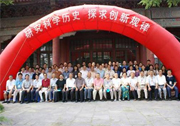| 中文题目: | 日本锦带桥营造技术的产生与传承 | ||||||
| 英文题目: | The Origin of the Design of the Kintai Bridge in Japan and its Maintenance Techniques | ||||||
| 作 者: | 任丛丛 | ||||||
| 刊物名称: | 自然科学史研究 | ||||||
| 发表年度: | 2018 | ||||||
| 卷: | |||||||
| 期: | 4 | ||||||
| 页码: | 1-2 | ||||||
| 中文摘要: | 日本锦带桥初建于1673年,是一座连续五跨的石墩木结构桥梁,端头的两跨为简支梁桥,当中的三跨为木拱桥,此种构造的桥梁在日本乃至世界都是孤例。初建至今,锦带桥历经数十次落架大修仍然以几乎原姿态伫立在原址。文章通过史料发掘、匠人访谈以及案例比较,分析了该桥的技术源流以及传承方式,从一个侧面展示了日本传统木结构营造文化的独具特色。 | ||||||
| 英文摘要: | The Kintai Bridge in Japan was constructed in 1673. It consists of two spans of girder bridges on both ends and three spans of arches in the middle. Chinese immigrants brought the techniques for building arches to Japan in the seventeenth century. The local carpenters adopted the idea of the arch,but whereas the Chinese built them in stone,the Japanese chose to construct their bridge in timber. This material transformation was achieved through innovations in technology,such as surveying,accurate drawing,the processing of wood and the use of metal parts,among other things. The Bridge has been maintained ever since by a society of local carpenters through a tradition of regular rebuilding and ongoing repairs. The engineering know-how to maintain the bridge has been passed down among these local carpenters,involving detailed elevation drawings,special tools and oral tradition. | ||||||





